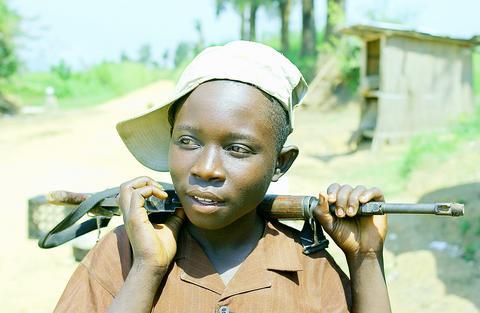A small boy of five stood on Bunia's main street gravely handing his orange plastic assault rifle to an older boy of about 15 in camouflage trousers and a fuschia pink T-shirt, a real AK-47 slung across his chest.
The older boy inspected it silently, a vacant look in his eyes, seemingly open to the idea it might work, just like his own rifle.

PHOTO: AFP
If Ituri, the most strife-torn district in eastern Democratic Republic of Congo (DRC), was once famed for the beauty of its forests and the music of its pygmies, it is now notorious for its child soldiers, many of whom are still young enough to ask strangers for sweets or biscuits.
This is in a country where child soldiers are the norm. A recent report by the UN accused 10 movements fighting in DRC of using fighters under the age of 18.
Aid workers in Ituri estimate that half of those fighting in Ituri are underage.
"It's a bit different here in Ituri in that the average age is younger and there is less forced recruitment (than elsewhere in DRC) and more voluntary recruitment. It's families and communities who send the children, the communities see it as their own protection," Johannes Webenig, the head of UNICEF for eastern DRC, told AFP in Bunia.
"You have to contribute to the war effort and there are different ways of contributing, one being to send a child to fight," he said.
The leaders of Ituri's armed groups like to play down the problem. Thomas Lubanga, the head of the Union of Congolese Patriots (UPC), the group that currently controls Bunia, claims he has "just a handful" of child soldiers and that all are orphans who are better off among his fighters than they would be out on the streets.
One of his opponents, Mathieu Ngudjolo, the leader of the Lendu Front for Patriotic Resistance in Ituri (FRPI) dismisses the problem.
Ghislain, a ragged child of 12 on the outskirts of Bunia, seemed flattered by the interest in the shots he had just fired into the air.
"Have I ever killed anyone? Yes I've killed five men already", he said proudly, brandishing, like his six fellow child soldiers, a rifle in one hand and a sharpened stick in the other.
For Ituri's boy soldiers, the line between real and make-believe is a thin one.
In the ranks of FRPI at a camp outside town, the boys have taken to dressing up. One wears a red straw hat of the style favored by the late Princess Diana. Another, not to be outdone, has made a headdress out of a baseball cap with a blue nylon tablecloth wrapped around it.
Yet others, a little older and fully aware of the fear they already inspire thanks to their weapons, have accentuated the effect by wearing wigs that give them dreadlocks flowing to the waist or a white papier-mache mask with a dehumanizing effect.

Malaysia yesterday installed a motorcycle-riding billionaire sultan as its new king in lavish ceremonies for a post seen as a ballast in times of political crises. The coronation ceremony for Malaysia’s King Sultan Ibrahim, 65, at the National Palace in Kuala Lumpur followed his oath-taking in January as the country’s 17th monarch. Malaysia is a constitutional monarchy, with a unique arrangement that sees the throne change hands every five years between the rulers of nine Malaysian states headed by centuries-old Islamic royalty. While chiefly ceremonial, the position of king has in the past few years played an increasingly important role. Royal intervention was

X-37B COMPARISON: China’s spaceplane is most likely testing technology, much like US’ vehicle, said Victoria Samson, an official at the Secure World Foundation China’s shadowy, uncrewed reusable spacecraft, which launches atop a rocket booster and lands at a secretive military airfield, is most likely testing technology, but could also be used for manipulating or retrieving satellites, experts said. The spacecraft, on its third mission, was last month observed releasing an object, moving several kilometers away and then maneuvering back to within a few hundred meters of it. “It’s obvious that it has a military application, including, for example, closely inspecting objects of the enemy or disabling them, but it also has non-military applications,” said Marco Langbroek, a lecturer in optical space situational awareness at Delft

The Philippine Air Force must ramp up pilot training if it is to buy 20 or more multirole fighter jets as it modernizes and expands joint operations with its navy, a commander said yesterday. A day earlier US National Security Adviser Jake Sullivan said that the US “will do what is necessary” to see that the Philippines is able to resupply a ship on the Second Thomas Shoal (Renai Shoal, 仁愛暗沙) that Manila uses to reinforce its claims to the atoll. Sullivan said the US would prefer that the Philippines conducts the resupplies of the small crew on the warship Sierra Madre,

AIRLINES RECOVERING: Two-thirds of the flights canceled on Saturday due to the faulty CrowdStrike update that hit 8.5 million devices worldwide occurred in the US As the world continues to recover from massive business and travel disruptions caused by a faulty software update from cybersecurity firm CrowdStrike, malicious actors are trying to exploit the situation for their own gain. Government cybersecurity agencies across the globe and CrowdStrike CEO George Kurtz are warning businesses and individuals around the world about new phishing schemes that involve malicious actors posing as CrowdStrike employees or other tech specialists offering to assist those recovering from the outage. “We know that adversaries and bad actors will try to exploit events like this,” Kurtz said in a statement. “I encourage everyone to remain vigilant